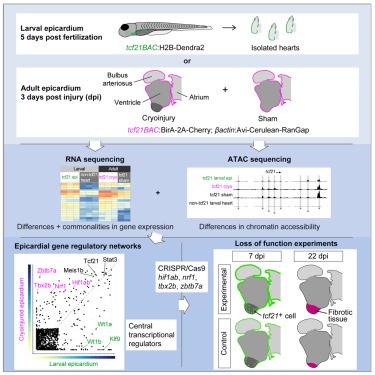Developmental Cell ( IF 11.8 ) Pub Date : 2024-01-17 , DOI: 10.1016/j.devcel.2023.12.012 Michael Weinberger , Filipa C. Simões , Trishalee Gungoosingh , Tatjana Sauka-Spengler , Paul R. Riley

|
Unlike the adult mammalian heart, which has limited regenerative capacity, the zebrafish heart fully regenerates following injury. Reactivation of cardiac developmental programs is considered key to successfully regenerating the heart, yet the regulation underlying the response to injury remains elusive. Here, we compared the transcriptome and epigenome of the developing and regenerating zebrafish epicardia. We identified epicardial enhancer elements with specific activity during development or during adult heart regeneration. By generating gene regulatory networks associated with epicardial development and regeneration, we inferred genetic programs driving each of these processes, which were largely distinct. Loss of Hif1ab, Nrf1, Tbx2b, and Zbtb7a, central regulators of the regenerating epicardial network, in injured hearts resulted in elevated epicardial cell numbers infiltrating the wound and excess fibrosis after cryoinjury. Our work identifies differences between the regulatory blueprint deployed during epicardial development and regeneration, underlining that heart regeneration goes beyond the reactivation of developmental programs.
中文翻译:

独特的心外膜基因调控程序驱动斑马鱼心脏的发育和再生
与再生能力有限的成年哺乳动物心脏不同,斑马鱼心脏在受伤后可以完全再生。心脏发育程序的重新激活被认为是心脏成功再生的关键,但对损伤反应的潜在调节仍然难以捉摸。在这里,我们比较了斑马鱼心外膜发育和再生的转录组和表观基因组。我们鉴定出心外膜增强子元件在发育过程中或成人心脏再生过程中具有特定活性。通过生成与心外膜发育和再生相关的基因调控网络,我们推断出驱动每个过程的遗传程序,这些过程在很大程度上是不同的。受伤心脏中再生心外膜网络的中央调节因子 Hif1ab、Nrf1、Tbx2b 和 Zbtb7a 的缺失导致浸润伤口的心外膜细胞数量增加以及冷冻损伤后过度纤维化。我们的工作确定了心外膜发育和再生过程中部署的监管蓝图之间的差异,强调心脏再生超越了发育程序的重新激活。



























 京公网安备 11010802027423号
京公网安备 11010802027423号